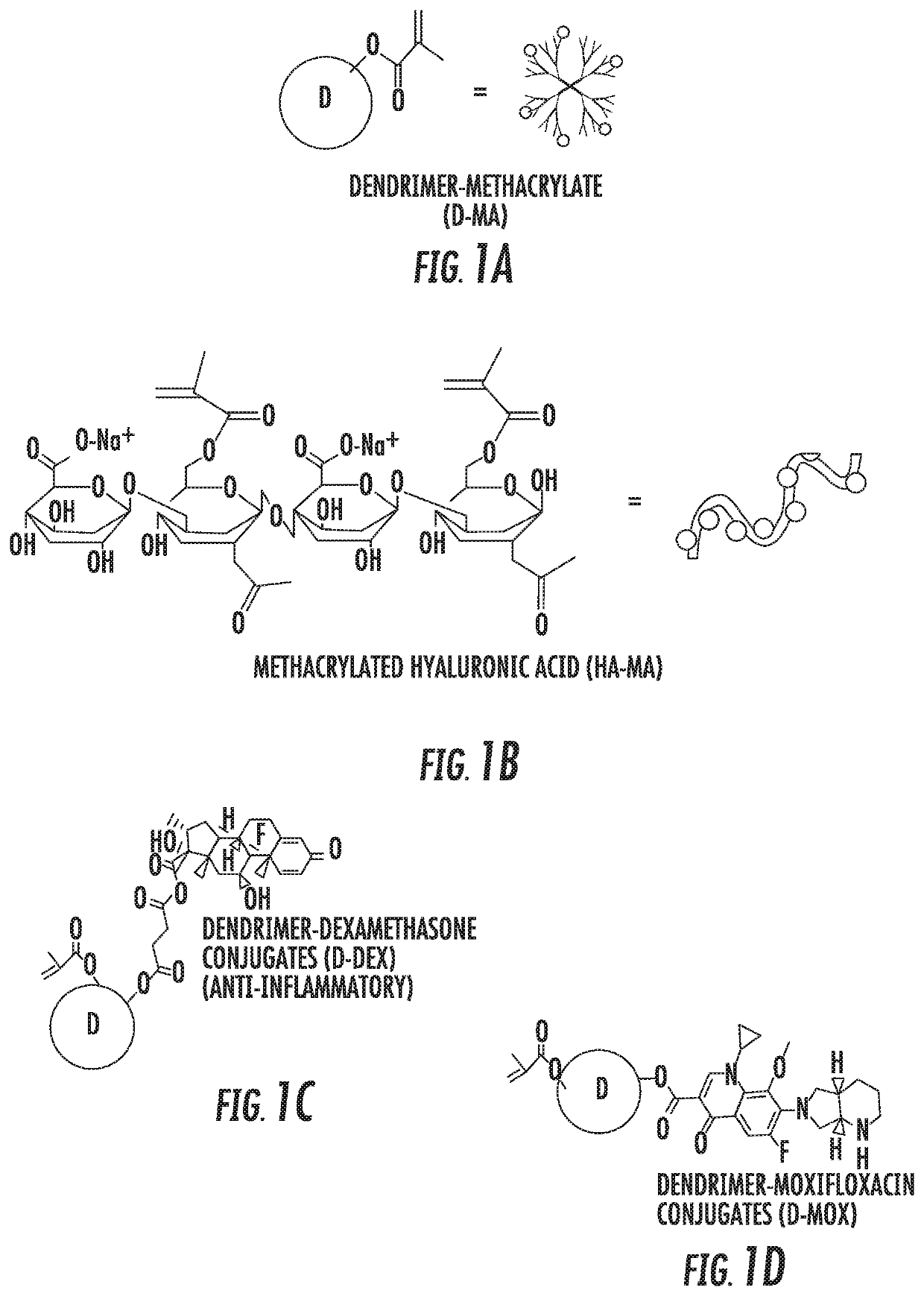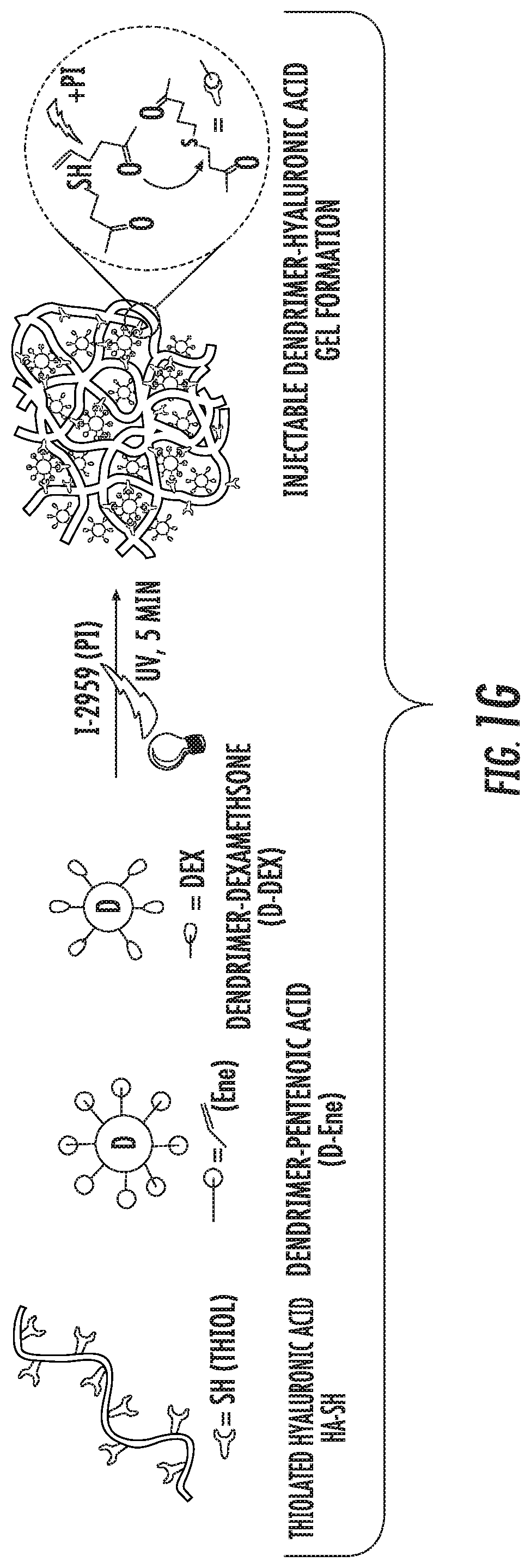Dendrimer-bioadhesive polymer hydrogel nanoglue and use thereof
a technology of bioadhesive and nano-glue, which is applied in the field of dendrimerbioadhesive polymer hydrogel nanoglue, wound repair and treatment of disorders, can solve the problems of requiring removal, uneven healing, and invasive procedures, and achieves the effects of preventing infection and scar tissue formation, reducing the time window of surgery, and reducing the risk of infection
- Summary
- Abstract
- Description
- Claims
- Application Information
AI Technical Summary
Benefits of technology
Problems solved by technology
Method used
Image
Examples
example 1
on of Photocrosslinked, Dendrimer-Hyaluronic Acid Hydrogel with Covalently Attached Dendrimer-Drug Conjugates
[0116]Materials and Methods
[0117]Modification of Dendrimer with Methacrylate (D-MA)(Formulation 1)
[0118]The surface of PAMAM G2 and G4 hydroxyl dendrimers are modified with methacrylate groups thereby enabling photo crosslinking (Component 1). Photo crosslinkable dendrimers (G2, G3, G4 and G6) are synthesized by adopting and optimizing previously established lab procedures. Briefly, methacrylic acid was covalently conjugated to the surface groups of the dendrimer using PyBOP / DIEA coupling reaction and the resultant product was purified and dialyzed using water. The formation of the product (D-MA) was confirmed using 1H NMR and HPLC (FIG. 1A).
[0119]Synthesis of Photo-Crosslinkable, Dendrimer-Drug Conjugate (Component 2)
[0120]Synthesized dendrimer dexamethasone conjugates with photocrosslinkable groups (MA-D-Dex) (G2-G6) were made that can enhance wound healing and prevent corn...
example 2
nd Mechanical Properties of Nanoglue Compared to Sutures in Ex Vivo Wounded Rabbit Eyeballs
[0132]Materials and Methods
[0133]Different types of corneal incisions were created on freshly enucleated mature rabbit eyeballs. We used different wound architecture and measured the burst pressure using custom designed manometer system with saline infusion. The nanoglue formulation with premixed formulations were applied on corneal incisions with different wound architecture and a argon green laser (325 nm) (for methacrylate system, formulation 1) or cobalt blue light (for thiol-ene click chemistry, formulation 2) was applied for 20-30 seconds resulting rapid photocrosslinked transparent ocular bandage that can withstand high intraocular pressures than compared to sutures. Briefly, a 3 mm linear incision was created in the central cornea resulting in a gaping wound. A tunnel incision was created. A 3-mm trephine central incision was created. The burst pressure with saline infusion was measure...
example 3
nd Mechanical Properties of Nanoglue Compared to Sutures in In Vivo Wounded Rat Cornea
[0136]Materials and Methods
[0137]In-vivo evaluation the rats were anesthetized with and pupils were dilated with tropicamide and 10% phenylephrine. A 2.75-mm keratome was used to create a full thickness central corneal incision. The blade was initially directed posteriorly, and after the penetration it was directed to the angle to avoid damaging the lens and its capsule. The incision was then either sutured (10-0 prolene or nylon) or glued with above mentioned nanoglue. Following the suturing / gluing, the corneal incision was confirmed to be closed with fluorescein and cobalt blue light.
[0138]Follow-up was performed 24, 72 hours, 7 days and 2 weeks following surgery. The rat corneas were imaged using optical coherence tomography (OCT) on day 7. The animals were clinically assessed for wound healing until day 14.
[0139]Results
[0140]Following the suturing / gluing with nanoglue, the corneal incision was ...
PUM
| Property | Measurement | Unit |
|---|---|---|
| pH | aaaaa | aaaaa |
| pH | aaaaa | aaaaa |
| temperature | aaaaa | aaaaa |
Abstract
Description
Claims
Application Information
 Login to View More
Login to View More - R&D
- Intellectual Property
- Life Sciences
- Materials
- Tech Scout
- Unparalleled Data Quality
- Higher Quality Content
- 60% Fewer Hallucinations
Browse by: Latest US Patents, China's latest patents, Technical Efficacy Thesaurus, Application Domain, Technology Topic, Popular Technical Reports.
© 2025 PatSnap. All rights reserved.Legal|Privacy policy|Modern Slavery Act Transparency Statement|Sitemap|About US| Contact US: help@patsnap.com



